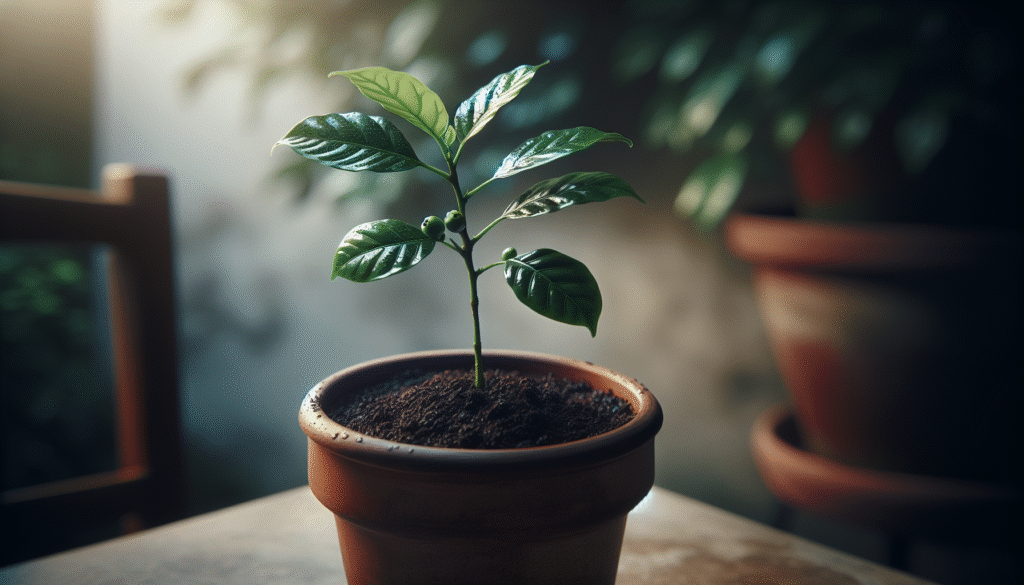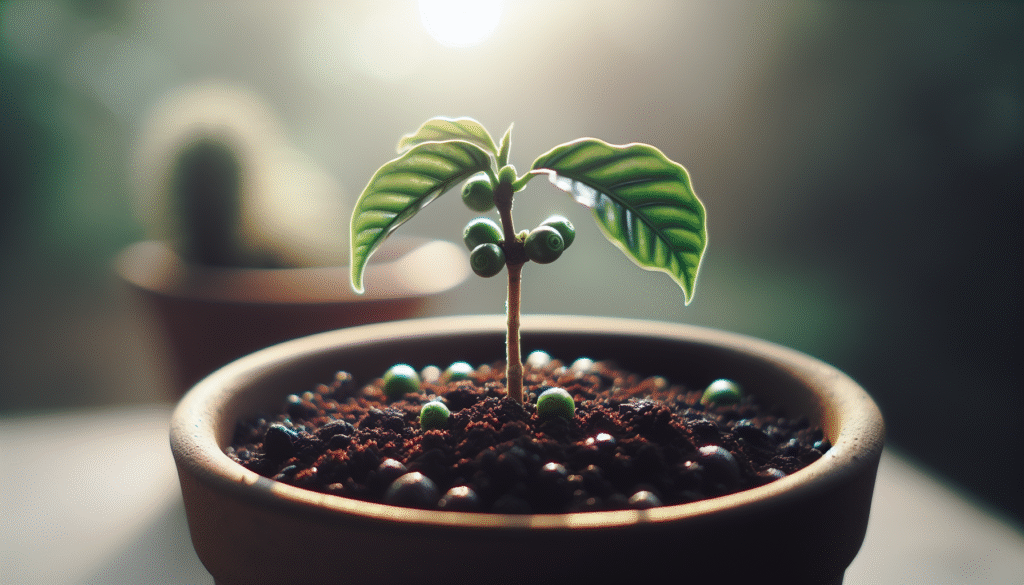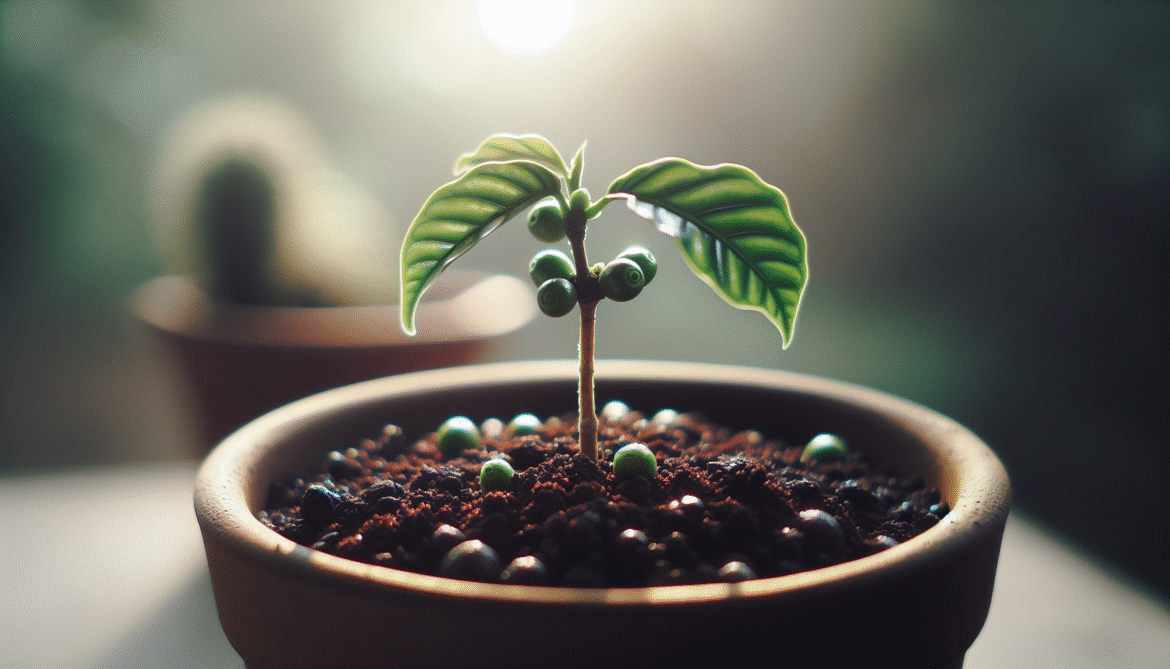Have you ever thought about growing your own coffee right in your garden or on your balcony?
Coffee Tree for Sale Ideal for Home Gardens
You can find coffee trees for sale that are perfectly suited for home gardens and container growing. With the right variety, care, and location, you can enjoy the beauty of glossy leaves and fragrant flowers as well as the satisfaction of harvesting your own coffee cherries.
Why Grow a Coffee Tree in Your Home Garden?
Growing a coffee tree gives you more than a single crop — it adds an attractive, evergreen shrub to your landscape and can become a conversation piece. You’ll experience the full lifecycle of coffee from blossom to cherry to cup, which makes the whole process rewarding and educational.
Cultivating coffee at home also allows you to control growing conditions, avoid pesticides, and experiment with small-batch processing and roasting. Even if you don’t produce a coffee bean yield that replaces store-bought coffee, you’ll still get ornamental value and a sense of accomplishment.
Types of Coffee Trees Suitable for Home Gardens
You’ll want to pick a variety that matches your climate, space, and patience. Here are the main species you’ll encounter:
Coffea arabica (Arabica)
Arabica is the most common choice for home gardeners because it produces high-quality beans and grows well in mild climates. The plant prefers cooler, higher elevation conditions and typically yields superior flavor compared to other species.
Arabica trees are generally smaller than some species and adapt well to container culture. They can be sensitive to frost and extreme heat, so you must provide protection or move containers indoors in marginal climates.
Coffea canephora (Robusta)
Robusta is hardier, tolerates warmer, more humid lowland conditions, and resists some pests and diseases better than arabica. The flavor is stronger and more bitter, and caffeine content is higher.
If you live in a warmer region or want a lower-maintenance plant, robusta can be a sensible choice. It’s less common in specialty coffee but useful for garden diversity.
Coffea liberica and Coffea excelsa
These species are less common in home gardens but are still available through specialty suppliers. They produce large cherries and distinctive flavors, with liberica sometimes used for ornamental value due to its large leaves.
You may prefer these if you want something unusual or if local conditions favor their growth. Availability can be limited, so check specialty nurseries or online sellers.
Where to Buy a Coffee Tree for Sale
You’ll find coffee trees at a variety of sources. Each source has pros and cons that affect price, plant quality, and aftercare support.
Local Nurseries and Garden Centers
Local nurseries often carry healthy, acclimatized plants that you can inspect in person. Staff can advise you about local climate suitability and care.
Prices may be higher than online bulk sellers, but shorter travel time for the plant reduces transplant shock.
Online Retailers and Specialty Growers
Online sellers offer a wide selection of varieties and sizes and can ship to your location. Specialty growers often provide heirloom or rare varieties.
Be mindful of shipping stress and quarantine/import rules for live plants if you’re ordering across state or country borders.
Farmers Markets, Coffee Farms, and Specialty Plant Shows
You can sometimes find coffee seedlings at farmers markets or directly from micro-growers. These plants may be acclimated to local conditions and come with grower tips.
Buying directly from a grower can also give you a chance to learn processing techniques or sign up for local workshops.
Table: Comparison of Purchase Sources
| Source | Pros | Cons | Best for |
|---|---|---|---|
| Local nursery | Inspect in person; acclimatized plants; local advice | Limited variety; possibly higher cost | Beginners, uncertain climates |
| Online retailer | Wide selection; rare varieties | Shipping stress; possible quarantine issues | Variety-focused gardeners |
| Specialty grower / farmer | Expert knowledge; acclimated stock | Limited availability; variable pricing | Enthusiasts seeking quality stock |
| Farmers market | Local plants; personal contact | Smaller selection; seasonal | Local gardeners wanting local acclimation |
Choosing the Right Variety for Your Climate
You’ll want to match your plant choice to temperature ranges, humidity, light, and elevation. Arabica does best in cooler, shaded conditions at moderate altitudes, while robusta tolerates heat and humidity better.
Make a simple climate checklist: mean annual temperature, frost risk, humidity, and whether you’ll grow the tree in-ground or in a container. Select a variety based on those factors to reduce stress and improve yield.
Table: Climate Preferences by Species
| Species | Ideal Temperature | Humidity | Frost Tolerance | Best Growing Conditions |
|---|---|---|---|---|
| Arabica | 15–24°C (59–75°F) | Moderate | Low | Shade, well-drained soil, higher elevation |
| Robusta | 24–30°C (75–86°F) | High | Very low | Warm, humid lowlands |
| Liberica / Excelsa | 20–28°C (68–82°F) | Moderate to high | Low | Tolerant of varied soils, ornamental value |

Selecting a Healthy Coffee Tree (What to Look For)
When you’re inspecting plants for sale, look for these signs of health: glossy, undamaged leaves without yellowing or spots; a straight stem or branching pattern without rot; and firm, white root systems if the plant is potted. Avoid plants with visible pests, sticky residues, or wilting.
Check the stem base for rot or soft tissue and look under leaves for scale, mites, or other insects. A healthy plant should react to touch with bounce in the leaves and should not be excessively leggy.
Table: Healthy vs Unhealthy Plant Signs
| Feature | Healthy Plant | Unhealthy Plant |
|---|---|---|
| Leaves | Glossy, green, intact | Yellowing, spots, holes |
| Stem & Roots | Firm, no rot | Soft base, root-bound, brown roots |
| Pests | None seen | Aphids, scale, mites visible |
| Soil | Moist but not soggy | Very dry or waterlogged |
Pot vs Ground Planting: Which is Best?
Deciding whether to plant in a container or the ground depends on your climate and space. Containers give you mobility — you can move plants into shade, shelter, or indoors during cold snaps. They’re ideal for patios, balconies, and areas with frost risk.
Ground planting can produce larger shrubs and higher yields if your climate is suitable. Trees planted in the ground often need less frequent watering once established, but they must be chosen with careful attention to frost risk and soil drainage.
Table: Pot vs Ground Planting
| Aspect | Container | Ground |
|---|---|---|
| Mobility | High (move for frost/heat) | Low |
| Root space | Limited (prune roots) | Unlimited |
| Yield potential | Moderate | Higher potential |
| Maintenance | More frequent watering, fertilizing | Less frequent watering once established |
| Frost protection | Easier (bring inside) | Harder (requires cover) |
Soil, Light, Water, and Temperature Requirements
You’ll need to tailor basic cultural conditions to suit coffee’s needs. Coffee trees are understory plants in nature, so they prefer filtered light, consistent moisture, and rich, well-draining soil.
Soil
Coffee prefers slightly acidic, fertile soil with good drainage and organic matter. Aim for a pH of about 6.0–6.5; if your soil is alkaline, amend with peat moss or sulfur to lower pH gradually.
Use a well-draining potting mix for containers and incorporate compost, leaf mold, or aged manure for nutrients. Avoid heavy clay without amendment because poor drainage can cause root rot.
Light
You’ll provide bright, indirect light or morning sun with afternoon shade in warmer areas. Coffee does not like full, harsh sun in hot climates, but too little light can reduce flowering and fruiting.
If growing indoors, place near an east- or north-facing window or provide filtered light with a sheer curtain or grow lights on a timed schedule.
Water
Coffee likes consistently moist but not waterlogged soil. Water when the top inch of soil feels slightly dry, and ensure containers have drainage holes.
Overwatering leads to root rot; underwatering causes leaf drop and stunted growth. Mulch can help maintain soil moisture and temperature if plant is in the ground.
Temperature and Humidity
Coffee thrives in moderate temperatures with stable humidity. Keep daytime temps ideally between 18–25°C (65–77°F) for arabica. Humidity around 50–70% is beneficial, so misting or a humidity tray helps when air is dry.
Avoid sudden temperature fluctuations, cold drafts, or frost, which can damage leaves and reduce yields.
Planting and Transplanting Your Coffee Tree
You’ll plant seedlings or young trees carefully to avoid shock. Choose a partially shaded location with well-drained soil or a container sized to allow root growth.
Steps for planting:
- Harden off indoor seedlings outdoors for a week in partial shade.
- Dig a hole twice as wide as the root ball and as deep.
- Amend backfill with compost and organic matter.
- Plant at the same depth as in the nursery pot and firm soil gently.
- Water thoroughly and apply a layer of mulch, keeping it away from the trunk.
When transplanting containers to larger pots, do it during the growing season to minimize stress. Trim circling roots and place the plant slightly higher in the new pot with fresh potting mix.
Care and Maintenance Throughout the Year
Coffee trees need consistent but seasonal care. You’ll perform general tasks like watering, fertilizing, pruning, and monitoring for pests.
Seasonal maintenance summary:
- Spring: Increase watering and start regular feeding; prune for shape after any late frosts.
- Summer: Maintain humidity and shade; watch for pests; thin fruit if necessary.
- Fall: Reduce feeding as growth slows; prepare for cooler months.
- Winter: Protect from frost; reduce watering; keep indoors if temperatures drop below critical thresholds.
Table: Seasonal Care Checklist
| Season | Key Tasks |
|---|---|
| Spring | Feed, prune, repot if needed, increase watering |
| Summer | Maintain shade/humidity, monitor pests, harvest if ripe |
| Fall | Reduce fertilizer, prepare frost protection, inspect roots |
| Winter | Protect from frost, reduce watering, maintain indoor light |

Fertilizing and Nutrient Needs
You’ll fertilize coffee trees to support steady growth and cherry production. Balanced fertilizers with an N-P-K ratio like 10-10-10 or slightly higher nitrogen during growth are common, but you should transition to a lower nitrogen, higher potassium blend when fruit sets to support fruit development.
Organic options include compost, fish emulsion, and worm castings applied several times per year. Apply a slow-release fertilizer in spring and supplement with liquid feed every 4–6 weeks during active growth.
Micronutrients such as magnesium, iron, and manganese can be important; leaf yellowing with green veins (interveinal chlorosis) often signals magnesium or iron deficiency and can be corrected with appropriate supplements.
Pruning and Shaping
You’ll prune coffee trees to maintain a manageable size, improve air circulation, and encourage lateral branching that bears fruit. Prune in early spring to remove dead, crossing, or overly leggy branches.
Shaping a single-stem tree or a multi-stem bush depends on your space and aesthetic preference. Regular light pruning is better than heavy cuts; remove only a third of the canopy at a time to avoid stressing the plant.
Pests and Diseases
Coffee trees are vulnerable to several pests and diseases, though home growers often face fewer problems than commercial plantations. Common pests include aphids, whiteflies, scale, and spider mites. Diseases you might see include root rot (from overwatering), leaf rust (Hemileia vastatrix), and fungal leaf spots.
Early detection and good cultural practices (proper watering, airflow, and sanitation) are your best defenses. Introduce beneficial insects if possible, wash small infestations with water and mild soap, and use copper or biological fungicides for fungal problems.
Table: Common Problems and Solutions
| Problem | Symptoms | Treatment |
|---|---|---|
| Aphids | Sticky residue, curled leaves | Wash off, insecticidal soap, ladybugs |
| Scale | Raised bumps on stems/leaves | Scrape gently, horticultural oil |
| Spider mites | Fine webbing, stippled leaves | Increase humidity, miticide, water spray |
| Root rot | Wilting, soft base, brown roots | Improve drainage, repot, remove rotted roots |
| Leaf rust | Orange spots on undersides | Remove infected leaves, fungicide, breed-resistant varieties |
Flowering, Fruit, and Harvesting
Your coffee tree will generally flower in response to environmental cues like rainfall or a change in humidity. Flowers are fragrant and white, followed by green cherries that ripen over several months to red (or yellow) depending on variety.
Harvesting is done when cherries are fully ripe; they will be firm and richly colored. For home use, you can pick by hand selectively, which ensures better-quality beans.
Timeline for fruiting:
- First fruit: Some trees start producing in 2–4 years, with better yields after 4–6 years.
- Flowering: Occurs seasonally; heavy flowering often follows a rain event or humidity change.
- Ripening: Cherries take several months to ripen after flowering.
Processing Coffee Cherries at Home
Processing your cherries converts the fruit into green coffee beans you can roast. There are three basic methods: wet (washed), natural (dry), and honey (semi-washed). Each affects flavor and requires different space, time, and care.
Steps for basic dry (natural) processing:
- Pick ripe cherries and wash off dirt.
- Spread cherries thinly on a raised drying rack in a well-ventilated, sunny spot.
- Turn cherries several times daily to ensure even drying and prevent mold.
- Dry for 1–3 weeks until cherries reach a hard, crackable state.
Steps for basic wet (washed) processing:
- Depulp cherries soon after harvest to remove the outer skin.
- Ferment the mucilage for 12–48 hours depending on temperature (monitor to avoid over-fermentation).
- Rinse thoroughly and dry the beans on racks until they reach the appropriate moisture level (~11–12%).
After drying, you’ll need to parchment/peel (hull) the dried cherries to get to the green coffee beans, then store them in a cool, stable environment before roasting.
Processing table: Comparison of Methods
| Method | Process | Flavor Impact | Space/Time Needs |
|---|---|---|---|
| Natural (Dry) | Dry whole cherries | Fruity, full-bodied | Requires sunny, ventilated space; longer time |
| Washed (Wet) | Depulp, ferment, wash, dry | Cleaner, brighter acidity | Requires water and fermentation control |
| Honey | Remove skin, partial mucilage left | Sweet, balanced | Moderate effort, careful drying needed |
Roasting and Brewing Your Home-Grown Coffee
Once you have green beans, you can roast small batches at home using a popcorn popper, stovetop roaster, or an electric home roaster. Roast profiles vary from light to dark; lighter roasts highlight origin flavors, while darker roasts bring forward caramelization and body.
After roasting, rest beans for 12–48 hours to degas, then grind and brew. Try small roasts to learn how roast level impacts flavor. Proper storage in airtight containers away from light and heat extends freshness.
Growing Coffee Indoors and as a Houseplant
You can grow coffee indoors if you have bright, indirect light and consistent humidity. Containers require regular feeding and repotting every 2–3 years.
Indoor coffee plants make excellent houseplants due to glossy foliage and occasional fragrant blooms. Monitor humidity with a tray or humidifier, and rotate the pot regularly for even growth.
Common Mistakes to Avoid
Avoid these pitfalls to increase your success rate:
- Overwatering: Coffee hates waterlogged roots; ensure drainage and moderate watering.
- Too much direct sun: Leaves can scorch if exposed to intense afternoon sun.
- Ignoring soil pH: Alkaline soil reduces nutrient availability and affects growth.
- Impatience with fruiting: Coffee takes several years to produce significant yields.
- Buying stressed plants without acclimation: Harden off new plants gradually when moving outdoors.
Cost Considerations and Value
You’ll encounter a range of prices for coffee trees depending on size, variety, and rarity. Small seedlings are inexpensive but require years to produce; larger, grafted, or specialty varieties cost more but may yield sooner.
Consider value beyond monetary returns: ornamental beauty, learning, and the satisfaction of processing and roasting a personal cup. If you aim to offset costs with home-grown coffee, estimate low yields for a few plants and scale expectations accordingly.
Legal and Import Considerations
If purchasing plants internationally or across state lines, you must consider quarantine and import rules in your area. Some regions restrict the movement of live plants to prevent pest spread.
Always verify seller compliance with local regulations and request phytosanitary certificates if required. This protects your garden and local ecosystem.
Final Tips and Resources
Start with one or two healthy plants and get comfortable with their care before expanding. Take notes about flowering and harvest times so you can fine-tune irrigation, light, and feeding schedules year to year.
Look for community resources such as local gardening clubs, coffee-growing forums, and specialty growers who can share cultivar-specific tips. Practical experience is the best teacher; small experiments with processing and roasting create a fun, iterative learning cycle.
If you purchase a coffee tree for sale, make a plan for the first year: acclimation, consistent watering, and gentle fertilization. With patience and proper care, you’ll enjoy the ornamental beauty, fragrant blooms, and the delightful possibility of brewing a cup from your own backyard harvest.
